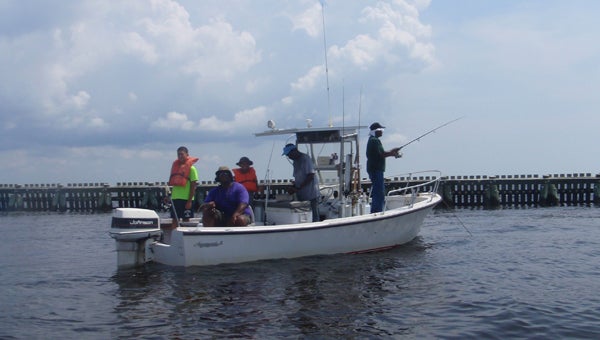Apparent fish shortage on the lower Pamlico River
Published 11:26 am Monday, September 15, 2014

FRED BONNER | CONTRIBUTED
BAD CATCH: Anglers from Washington and Greenville try their luck by fishing with baited hooks rigged for bottom fishing. They’re fishing just to the inside of the jetty at Belhaven.
It was really encouraging in early May and late June to see how the fishing for speckled trout and puppy drum had obviously survived last winter’s cold spells. The number of trout was, perhaps, a little lower than we’d seen in the past year, but the trout were there and, apparently, were doing well. Numbers of mullets were jumping in the grass beds (another encouraging sign) and there seemed to be plenty of forage around for the larger fish to feed on.
A couple of weeks ago, all the good signs we’d seen for the fishing seemed to be disappearing. A lot of good fishermen that knew the lower Pamlico River waters on the southern side of the river were not having much luck at all. Crab pot numbers were still very low in and around the Indian Island section where South Creek flows into the Pamlico River and that indicates that something is not well with the population of blue crabs in that area too.
Other indications of something being wrong with the water near the confluence of South Creek and the Pamlico River were also not good. Usually at this time of the year you’d see millions of juvenile menhaden dimpling at the surface and, now, there were none. Where numerous jumping mullets could be seen carrying out their acrobatics a few weeks ago, we saw none. Checking small creeks in the area that held a super abundance of “green tail” shrimp last year, we saw no signs at all now. There were not even any of the stinging jellyfish that are so worrisome to swimmers at this time of the year.
Some local anglers that were setting recreational gill nets in the area were catching hardly any fish at all and even the sting rays that were fouling nets a month ago were gone. The playful bottlenose dolphins that entertained people a few weeks ago were not to be seen.
Serious questions began to arise about something being wrong with the water in this section of the lower Pamlico River and, as usual, several local fishermen pointed the finger at the huge Potash Corp of Aurora, which has their mine and processing plant just to the west of the questionable area of water.
We’d not seen fish kills in the area and what few crabs, fish or other forms of aquatic life were in the area were not showing any signs of distress. There just simply seemed to be very few fish in this one small area of the Pamlico River watershed.
Checking with fishermen who were fishing in the upper sections of South Creek near the Town of Aurora, they were reporting lots of activity in and around the Highway 33 bridge over South Creek and, despite the fact that the NCWRC launching ramp in Aurora was closed for repairs, everything seemed to be about normal for the water in this area.
We decided to check on other areas in the Pamlico watershed to see if there any observable signs of a problem there.
A couple of us took the ferry across to the north side of the Pamlico River and launched our boat at the Wildlife Resources ramp in Belhaven to see if this area was experiencing the same problems with the lack of aquatic life that appeared to be occurring on the south side of the river.
The difference between the two areas was dramatic. Mullets were swarming in the Pungo Creek and other side creeks in the Belhaven area. Anglers were catching good numbers of speckled trout and the size of the trout was very acceptable. Aquatic life seemed to be thriving the way we expect to find in our lower south side section of the Pamlico River.
When contacted to see if they had detected any water quality problems in the South Creek/lower south side of Pamlico River, the N.C. Water Resources folks in Raleigh gave the area an “all clear” in terms of water quality. They offered the idea that the brackish water in that area might be stratified and low dissolved oxygen levels in the area have become unacceptable to the fish.
Basically, stratification of our estuarine waters occurs when there’s a layer of colder water about halfway down in the water column. This stratified colder water can be very low in oxygen during the summer months, while the upper layer of water is considerably and distinctively warmer and richer in dissolved oxygen.
When such things as a sudden shift in the wind’s direction or force causes two distinct layers of water to mix, it can cause the entire water column to have unacceptable oxygen levels. Fish kills do occur when these things happen and are, in many cases, a perfectly normal thing. John Lawson’s earliest history of eastern North Carolina reported these fish kills.
When the fish and other aquatic life in this lower Pamlico River/South Creek area, sensed a localized problem, they may have moved into more suitable habitats to wait for the lower river and creek to return to better oxygen levels. Hopefully the living conditions in this area of Beaufort County will soon return to acceptable levels and the lower Pamlico River and mouth of South Creek will again offer anglers the same high quality fishing that they’re accustomed to.





